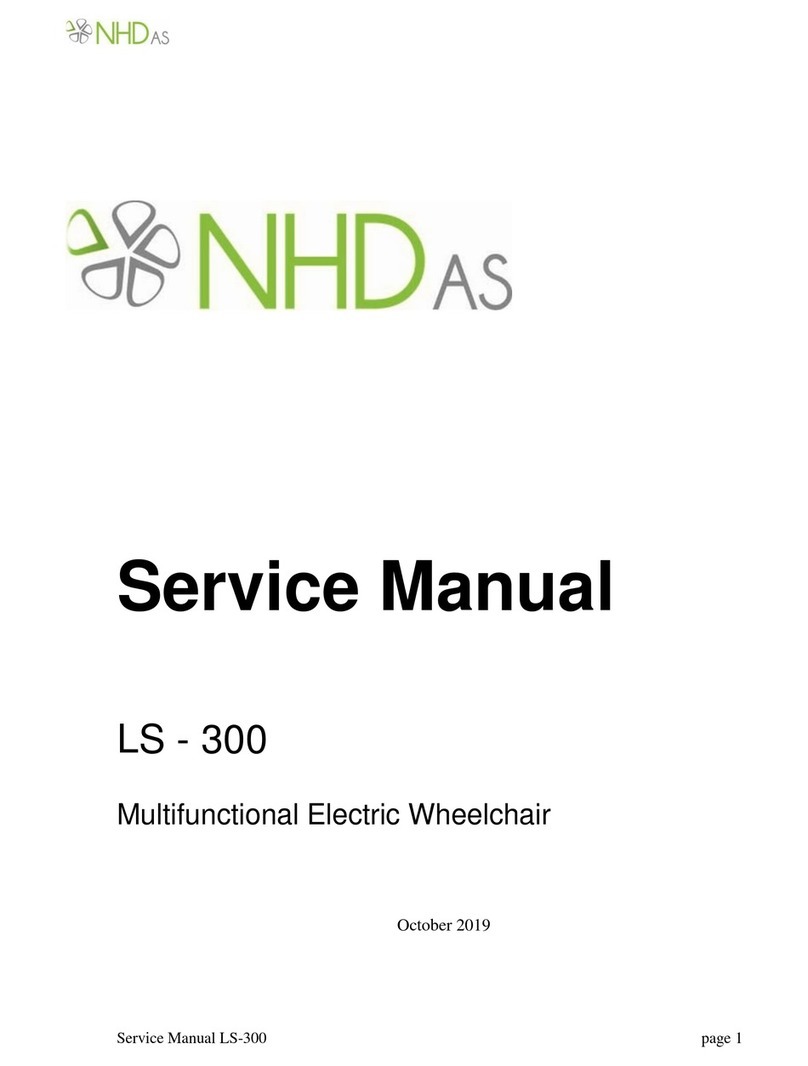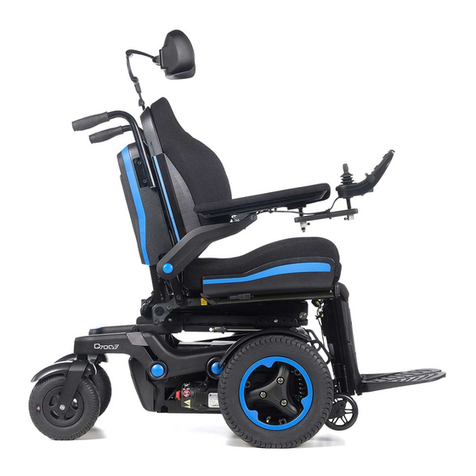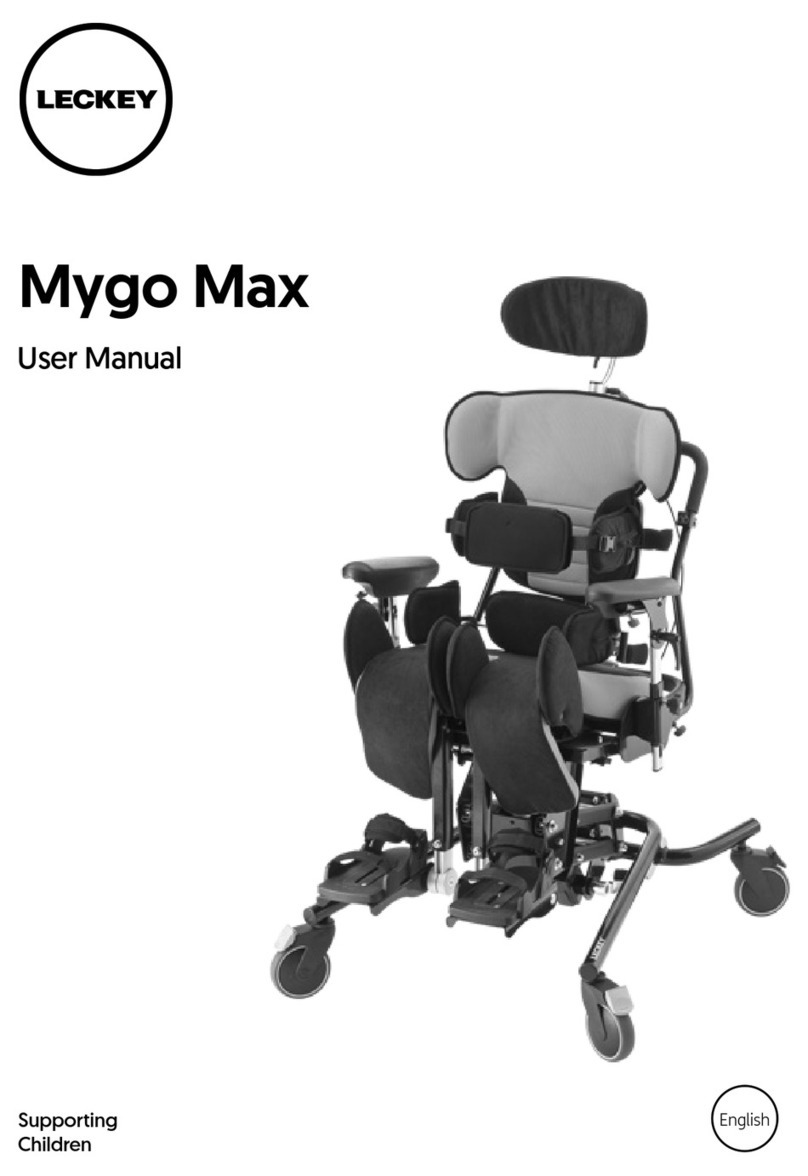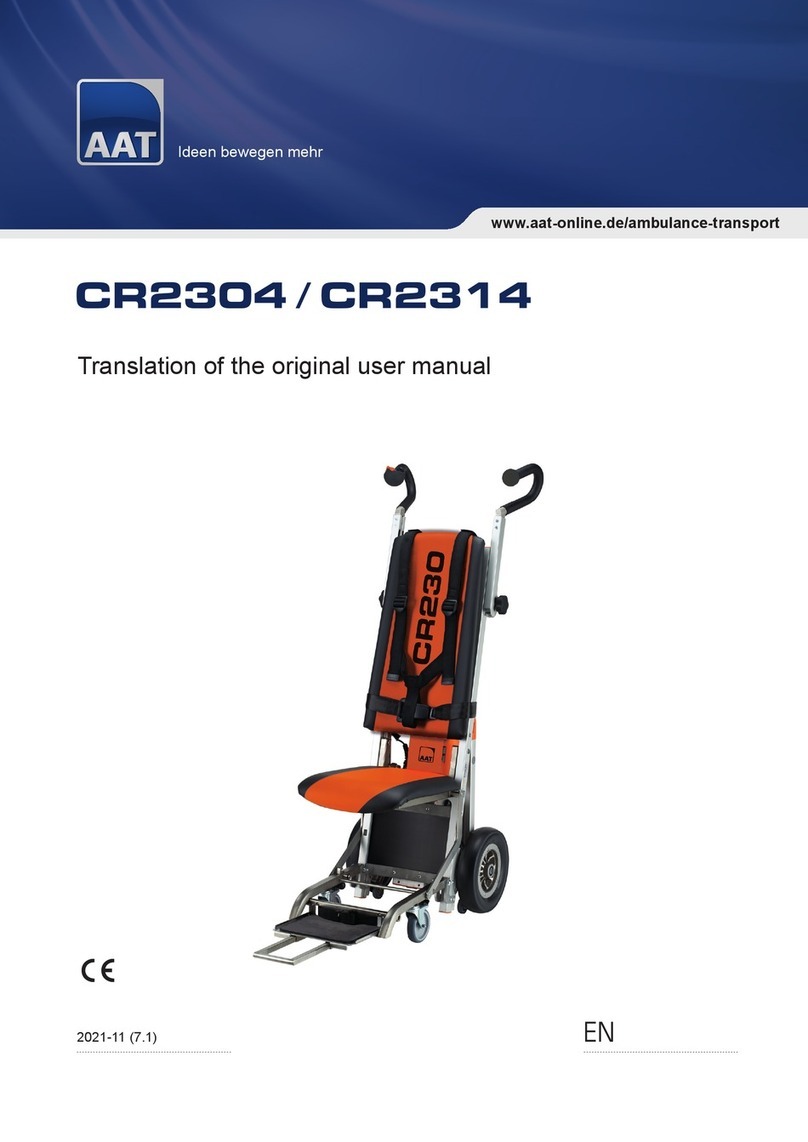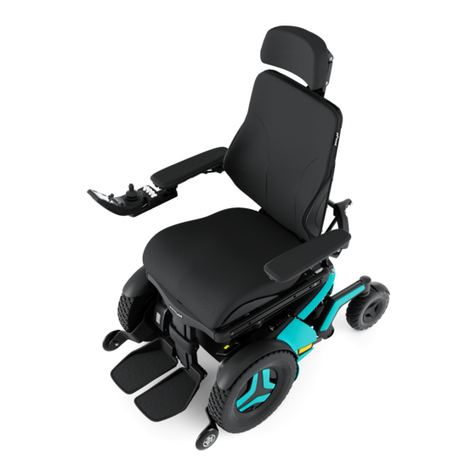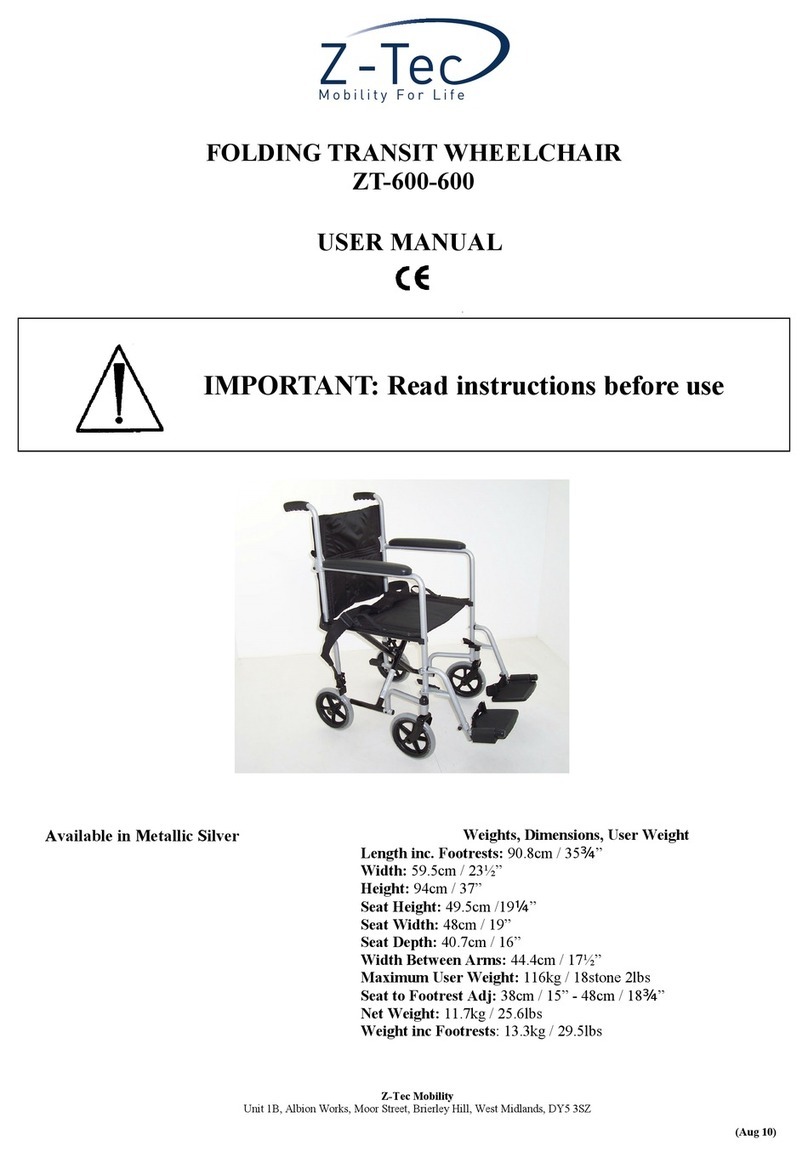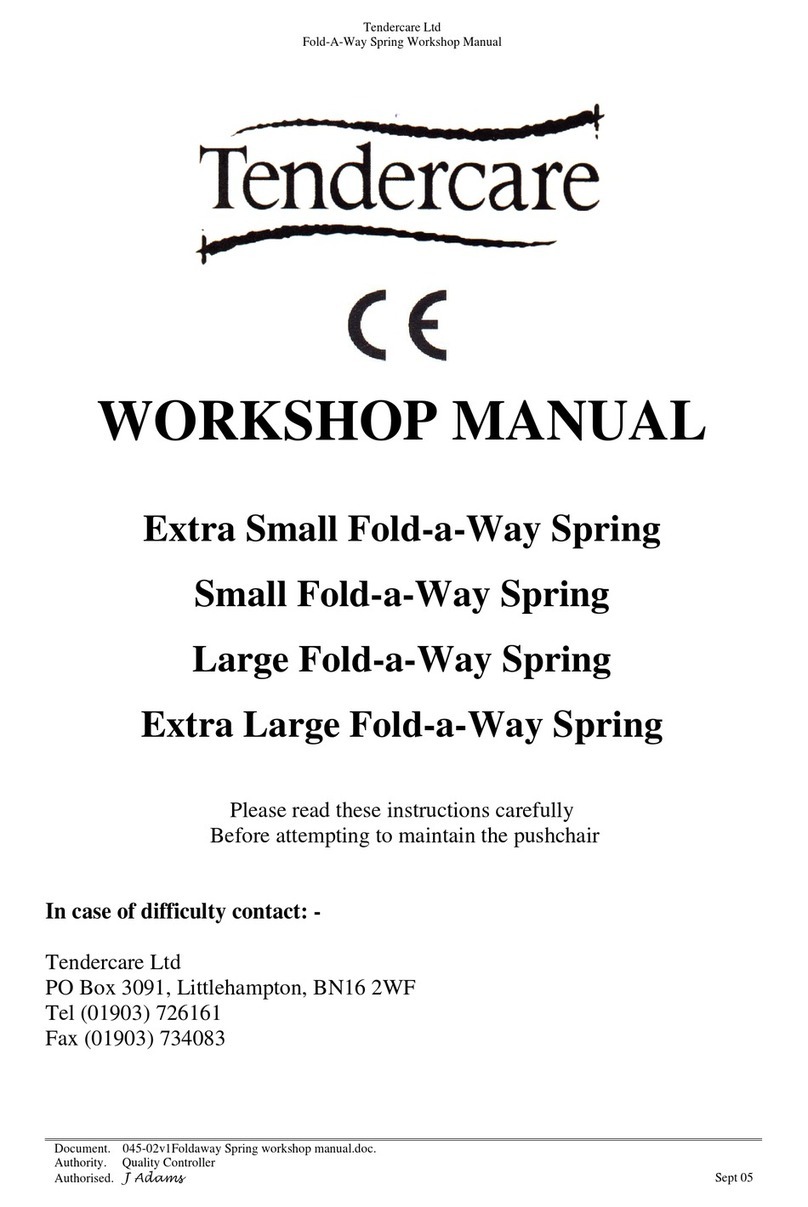NHD AS LS-300 User manual

User`s
Manual
LS - 300
Multifunctional Electric Wheelchair
Juni 2018
Revision Sheet

User`s Manual LS-300 Page ii
Release No.
Date
Revision Description
Rev. 1
15.06.18
Rev. 2
20.06.18
Guideline for transportation in a vehicle
Rev. 3
26.06.18
Feedback from Dahl Engineering –Mounting must be included

User`s Manual LS-300 Page iii
1. Preliminery note.........................................................................................................................................2
2. Important safety instructions....................................................................................................................3
General safety instructions ................................................................................................................................................ 3
Notes on EMC interference ................................................................................................................................................ 4
Brakes................................................................................................................................................................................. 4
Intended Use ...................................................................................................................................................................... 4
Indications .......................................................................................................................................................................... 4
Contraindications ............................................................................................................................................................... 4
Declaration of conformity .................................................................................................................................................. 4
3. Product Overview......................................................................................................................................5
Delivery .............................................................................................................................................................................. 5
Check the delivery .............................................................................................................................................................. 5
Identification label ............................................................................................................................................................. 5
Overview ............................................................................................................................................................................ 6
4. Use of the wheelchair...............................................................................................................................7
Basic settings................................................................................................................................................................... 7
Control............................................................................................................................................................................... 7
Guideline for transportation in a vehicle……………………………………………………………………………...12
Mounting of the Dahl docking adapter on the wheelchair……………………………………………………….….20
Technical specifications................................................................................................................................................ 23
Charging ......................................................................................................................................................................... 26
5. Examination of the wheelchair...............................................................................................................28
Checking the tires.......................................................................................................................................................... 28
6. Cleaning and disinfecting.......................................................................................................................29
Cleaning.......................................................................................................................................................................... 29
Disinfection..................................................................................................................................................................... 29
Re-use of the wheelchair.............................................................................................................................................. 29
7. Maintenance.............................................................................................................................................30
Replacing the batteries................................................................................................................................................. 30
Repair / maintenance plan ........................................................................................................................................... 31
8. Transport...................................................................................................................................................32
9. Storage......................................................................................................................................................33
10. Disposal.....................................................................................................................................................33
11. Manufacturer.............................................................................................................................................34

User`s Manual LS-300 Page 2
1. Preliminery note
Thank you for purchasing a LS-300 multifunction wheelchair. The LS-300 can be optimally
adapted to your physical needs. All settings can be adjusted electronically, steplessly via the
joystick. You can adjust seat height, seat angle, backrest angle, knee angle, armrest position,
footplate position and leg length. Its size combined with its high functionality makes it ideal use
as driverseat in cars, but it is also ideal for indoor and outdoor use.
Please charge the battery completely before first use, see Chapter 4 „Charging“, Page 16.
To get the most out of all the benefits of this wheelchair, read the instructions carefully, do not
throw it away, but keep it handy.
Maintenance work or technical repairs may only be carried out by authorized specialist dealers.
LS-300

User`s Manual LS-300 Page 3
2. Important safety instructions
General safety instructions
•To avoid falls and accidents, it is important to familiarize yourself with your new wheelchair
in a safe environment, on a level surface. We recommend to bring in a companion at the
beginning.
•When adjusting and the wheelchair there is a risk of entrapment for the user as well as for
third persons who are in the immediate vicinity of the wheelchair.
•Avoid driving against steps or curbs.
•When transporting the wheelchair, it must be secured against rolling away. Use the fastening
devices.
•In the event of prolonged exposure to the sun, parts of the wheelchair may heat up, there is a
risk of burns.
•Weight transfer due to body movement or load may increase the risk of tipping.
•Please do not hang objects such as carrying bags, backpacks etc. on the wheelchair, this is not
intended. Attached loads, change the statics and can lead to falls and modified braking
behavior.
•When driving on uphill or downhill gradients, make sure that the seat surface is not raised as
this will limit the stability and can cause the wheelchair to fall over.
•Note that the braking distance is longer on inclines than on level ground.
•When overcoming slight obstacles or height differences, you should raise the seat slightly, if
at all, and leave the backrest as steep as possible to prevent the wheelchair from tipping over.
•Do not bring damaged batteries into contact with skin, as the contents of the battery are
harmful to health and can be corrosive.
•Only charge the battery in ventilated areas.
Be sure to keep your arms
and hands on the armrest
during electrical adjustment
of the wheelchair. Third
parties should not touch the
marked areas with their
hands or fingers.
Entrapment!

User`s Manual LS-300 Page 4
Notes on EMC interference
•Although all EMC directives have been observed, it is possible that the power wheelchair
may be replaced by other electrical systems, such as electric motors, electric doors, alarm
devices in department stores, mobile phones or the like is disturbed or disturbs.
Brakes
The wheelchair brakes to a halt when the joystick is released. The functionality should be
checked before each use.
Attention: On gradients, the braking distance is extended.
Intended Use
The wheelchair is exclusively for the transport of disabled persons.
Indications
Inability to walk or severe disability caused by
• paralysis
• Joint contractures, joint damage - not on both arms
• loss of limbs
• Limb injury
The use of an electric wheelchair is intended for persons who, due to the disability, are unable to
carry hand-driven wheelchairs, but have the ability to properly operate the electric wheelchairs.
Contraindications
Electric wheelchairs are unsuitable for people
• with reduced eyesight
• with severe balance disorders
• with severe limitations of cognitive abilities
• with inability to sit
Declaration of conformity
NHD, as the manufacturer, declares on its sole responsibility that the LS-300 electric wheelchair
complies with the requirements of Medical Directive 93/42 / EEC.

User`s Manual LS-300 Page 5
3. Product Overview
Delivery
After receiving your goods, please check the contents for completeness
Packing
Electric wheelchair
Control device
Charger
Check the delivery
Your LS-300 wheelchair is delivered ready for use, no further assembly is necessary.
Please check if all listed elements are present.
Identification label
The identification label is located behind the right drive wheel, see Fig. Page 6.
•Manufacturer
•model
•Item number
•Max. user weigth
•Max. safe gradient
•CE mark
•Production date

User`s Manual LS-300 Page 6
Overview
A
Headrest
B
Backrest
C
Armrest
D
Electrical control with connection for the charging unit
E
Seat cussion
F
Footrest
G
Rear Wheel
H
Front Wheel
I
Footrest plate
J
Battey unit
K
Identification label
Upon request, your wheelchair will be delivered with a lap belt, which is attached to the side of
the seat plate. This belt does not serve as a safety belt during car rides. To close, push the two belt
parts into each other until they click into place. Open the clasp by pressing on "Press".
A
B
C
D
H
G
F
E
I
J
K

User`s Manual LS-300 Page 7
4. Use of the wheelchair
Basic settings
The individual mechanical adjustments before the first use of your electric wheelchair, must be
made by the authorized dealer.
Control
With the control you control the settings of your wheelchair, as well as the driving characteristics.
The control offers the possibility to electronically adjust the seat adjustment, it is located on the
right armrest and can be operated with little force.
Please read carefully the safety instructions before first use.
Press the upper button to turn on the controller.
The "Mode" button takes you to the two main menus, setting mode or driving mode.
Setting
Attention: Please note that major changes, such as extreme positioning of the backrest or leg rest
and / or high height adjustment, can negatively affect the stability. Also, the braking distances can
be extended. If you have any questions, please consult your dealer.
If one or more areas of the wheelchair light in the display next to the Mode button lights up, you
are in setting mode. With a right or left movement of the joystick you can switch between the
areas to be set. If you move the joystick forwards or backwards in this mode, you change the
position of the illuminated areas.
I
II
III

User`s Manual LS-300 Page 8
The following ranges can be infinitely adjusted via the control:
- Backrest at an angle
- seat angle
- Length of legrests
- Angle of legrests
- Seat height
Angle of legrest Lengths of legrest
Backrest
Seat angle
Seat height

User`s Manual LS-300 Page 9
Driving mode
If you press the on-off switch, if no areas in the display next to the mode button light up, you are
in driving mode.
When you move the joystick forward, the wheelchair moves forward.
Brake by releasing the joystick. By releasing the joystick the wheelchair comes to a standstill.
To change from the setting to the driving mode, proceed as follows:
Press the Mode button, move the joystick to the right (or left) until no areas in the display next to
the Mode button light up.
Speed
The speed is controlled while driving with the joystick, if you move the joystick only slightly, the
ride is slower. Push the joystick to the stop to drive maximum speed. The maximum speed can be
set in advance in five different driving profiles. (see section driving profiles)
a.) On and off switch
b.) Charge level
c.) Signal horn
d.) Display of the areas to be set
e.) Mode key to change the
areas to be set
f.) Display of the max. speed too
adjustment of the driving profiles
g.) Option key for determining the
Speed in the driving profiles
a
b
c
d
e
f
g

User`s Manual LS-300 Page 10
Set driving profiles
You can define five different driving profiles with the controller. This allows the maximum speed
to be programmed differently. Especially indoors it is recommended to set the maximum speed
lower. Press the "Mode" button and move the joystick up or down to access the corresponding
menu. With the help of the selector keys you can now preset the maximum speed and specify it in
one of the five possible profiles.
Change of direction
If you move the joystick to a side position while driving, the wheelchair follows and moves in
that direction.
Attention: The wheelchair has a low turning radius, make sure that no people or objects are too
tight and you or others injured.
For reversing, move the joystick towards you.
Attention: Please make sure that there are no persons or obstacles behind you.
Overcoming obstacles
Drive slowly and head-on towards the obstacle to be overcome, staying about 50 cm in front of it.
Make sure the wheels are perpendicular to the obstacle. Now drive at a steady, sufficient speed
over it.
Attention: Do not try to drive over obstacles higher than 50 mm.
Do not drive over the obstacle at an oblique angle, there is a risk of tipping.
Freewheel function
The power wheelchair can be set in a manual sliding mode. This function may only be set by a
companion. The following step is necessary for this:
Loosen the center handles on the brake release handles. ("Unlock" and "lock")
Attention: The wheelchair has no braking function in sliding mode.

User`s Manual LS-300 Page 11
The controller is automatically switched off in this mode.
After the shift, switch the system back to normal operation. If the controller is not yet active,
switch it off and on again, now your electric wheelchair is again driveable.
Getting in and out
Bring your current seat as close as possible to the side of the LS-300. Make sure that the
controller is turned off to prevent uncontrolled rolling. Fold up the armrest and footplate. Now
slip sideways onto the seat of the LS-300, making sure that you are as far back as possible in the
seat. Now fold down the footrest and the armrest again.
Armrests
The armrests can be folded up completely to make getting in easier.

User`s Manual LS-300 Page 12
Foot plate folded up
Lock with the help of the controller
To secure the control, please proceed as follows:
Press the on button until a beep sounds. Release the button and slide the joystick forwards until
you hear another beep. Release the joystick. Then move the joystick backwards until you hear
another beep, release the joystick and a long beep sounds. The electric wheelchair is now locked
against driving away. They realize. To unlock the wheelchair, follow the same procedure.
Guideline for transportation in a vehicle
The LS-300 complies with the requirements specified in ISO
7176-19:2008. It has been designed and tested according to the
ISO 7176-19:2008, for transportation in a occupied position,
forward facing in a vehicle.
The wheelchair is designed to use a 4-point heavy duty
webbing restraint. for this matter the wheelchair has two
brackets on the front end and two brackets on each rear side of
the chassis. The brackets are indicated with a sticker. These
anchoring point shall be used to connect the tie-down belt to.
4 point Tie-down belts
For the tie down belt we advice to use a Dahl heavy duty tie-down belt, model 501780 or 501781.
The angle of the straps should be around 45° to the horizontal plane. This is in order to have
maximum effect in vertical and horizontal direction.

User`s Manual LS-300 Page 13
Tie down straps Tie down straps
under 45° angle under 45° angle
The straps have to be connected to the vehicle at suitable anchor points. Make sure that the tire
pressure is at the recommended level so the straps can have maximum effect. Make sure the
straps are tightened to maintain optimal security.
WARNING:
Poor fixations of the wheelchair in a vehicle might cause damage to the vehicle itself, the
wheelchair or the passengers inside the vehicle while driving. Not using a car safety belt while
sitting in a wheelchair might lead to serious injuries in case of an accident.
Note:
The access to, and maneuverability in, motor vehicles can be significantly affected by wheelchair
size and turning radius. Smaller wheelchairs and/or wheelchairs with a shorter turning radius will
generally provide greater ease of vehicle access and maneuverability to a forward-facing position
in the vehicle. Also the internal size of the vehicle will have a great influence of the
maneuverability into and out of the vehicle. Make sure there are loose object inside the vehicle
which might make entering en positioning inside the vehicle more complicated.
Although the wheelchair is designed and tested according to the ISO 7176-19:2008 requirements,
we also advice: wheelchair users should transfer to the vehicle seat and use the vehicle-
manufacturer-installed restraint systems whenever it is feasible, and the unoccupied wheelchair
should be stored in a cargo area or secured in the vehicle during travel.
For more information, tie down kits for vehicles and or further information about tie-down belt
and occupant 3-point safety belt, please visit the website of Dahl engineering at; WTORS.com

User`s Manual LS-300 Page 14
WARNING:
Postural supports should not be relied on for occupant restraint in a moving vehicle, unless they
are labelled as being in accordance with the requirements specified in ISO 7176-19:2008.
Safety belt
If the user is transported in his wheelchair, it is necessary to use a car safety
belt to secure the wheelchair user.
Positioning of the car safety belts for wheelchair users.
The wheelchair has been crash tested using tie down belts, and a 3-point occupant safety belt. We
advise you to use a Dahl 3-point occupant safety belt model 500984 system or a system that is
equally specified. It is very important to use the safety belt in the right angles according to the
wheelchair user. The angle for the pelvis part (2) of the safety belt must be in angle of 30- 75 °
with the horizontal plane. (see picture below). Also the side angle should stay between the
vertical plane to maximum of 15° angle with the vertical plane. (see picture below).
Optimal angles for a safety belt used by the wheelchair user

User`s Manual LS-300 Page 15
The shoulder part (1) of the safety belt should be positioned according to the figure below.
Shoulder safety belt positioning
Note:
Please obtain the following points for a optimal personal safety of the wheelchair user:
- the pelvic belt should be worn low across the front of the pelvis, so that the angle of the pelvic
belt is within the preferred zone of 30° to 75° to the horizontal, as shown in figure above.
- a steeper (greater) angle within the preferred zone is desirable.
- belt restraints should not be held away from the body by wheelchair components or parts, such
as the wheelchair armrests or wheels, along with an illustration similar to that of the figure shown
above.
- upper torso belts should fit over the shoulder and across the chest, as illustrated in figure of the
shoulder safety belt positioning.
- belt restraints should be adjusted as tightly as possible, consistent with user comfort.
- belt webbing should not be twisted when in use.
Picture of improper belt fit Picture of proper belt fit

User`s Manual LS-300 Page 16
Note:
Please, make sure the following conditions are fulfilled to obtain a safe transportation:
- Whenever possible the occupied wheelchair shall be located in a forward-facing configuration
and secured by the tie downs in accordance with the WTORS ( wheelchair tie down and
occupantrestraint system) manufacturer’s instructions.
- This wheelchair is suitable for use in vehicles and has met the performance requirements for
travelling forwards-facing in frontal impact conditions. Its use in other configurations within a
vehicle has not been tested.
- The wheelchair has been dynamically tested in a forward-facing orientation with the ATD
(anthropomorphic test device) restrained by both pelvic and upper torso belts.
- Both pelvic and upper torso belts should be used to reduce the possibility of head and chest
impacts with vehicle components.
- When possible, other auxiliary wheelchair equipment should be either secured to the wheelchair
or removed from the wheelchair and secured in the vehicle during transit, so that it does not break
free and cause injury to vehicle occupants in the event of a collision.
- Positioning supports should not be relied on for occupant restraint in a moving vehicle unless
they are labeled as being in accordance with the requirements specified in ISO 7176-19-2008.
- The wheelchair should be inspected by a manufacturer’s representative before reuse following
involvement in any type of vehicle impact.
Note:
- Alterations or substitutions should not be made to the wheelchair securement points or to
structural and frame parts or components without consulting the manufacturer.
- Only use "gelled electrolyte" batteries on powered wheelchairs when used in a car.
WARNING:
Special care should be taken when applying the occupant restraint to position the seatbelt buckle
so that the release button will not be contacted by wheelchair components during a crash.
Backrest, legrest and headrest settings during transportation.
During transportation in a occupied position, the backrest of the wheelchair needs to be set into
an upright position. The legrest should be in a knee angle close to 90 degrees. The headrest needs
to be adjusted well so it will catch the head of the wheelchair user during the rebound of an
impact, this to reduce the risk of a whiplash.

User`s Manual LS-300 Page 17
Recommended position of the backrest, legrest and headrest
Transportation using Dahl Docking station
LS-300 has been crash tested using a Dahl docking station tie down system according to
7176-19:2008 and 10542-1:2012, where the wheelchair is facing forward in driving direction
(driving direction like the driver seat).
LS-300 crash test using Dahl docking station.

User`s Manual LS-300 Page 18
The locking of the wheelchair into the Dahl Docking station make it much easier to lock down
the wheelchair for occupied transportation. It can be used also for wheelchair users who want to
drive the car by themselves.
The system is self locking and can be release by pushing a button. The locking device will open
up for a certain time to make the un docking possible.
WARNING:
The Dahl Docking station is only allowed to build in to a vehicle by trained and authorized staff
of a registered car adaptation company. For ordering the Dahl Docking and its accessories,
please contact Dahl Engineering in Denmark for further details. You can find Dahl at;
WTORS.com
The Dahl Docking station
Dahl Docking station Dahl docking station mounted on the floor
Docking station and docking plate on chassis
Other manuals for LS-300
2
Table of contents
Other NHD AS Wheelchair manuals
Popular Wheelchair manuals by other brands
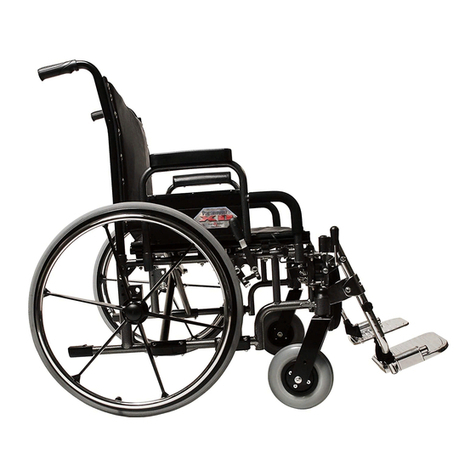
Everest & Jennings
Everest & Jennings Paramount XD user manual
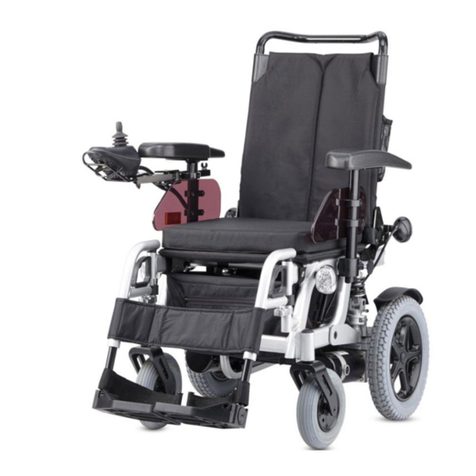
Bischoff & Bischoff
Bischoff & Bischoff Eltego instruction manual
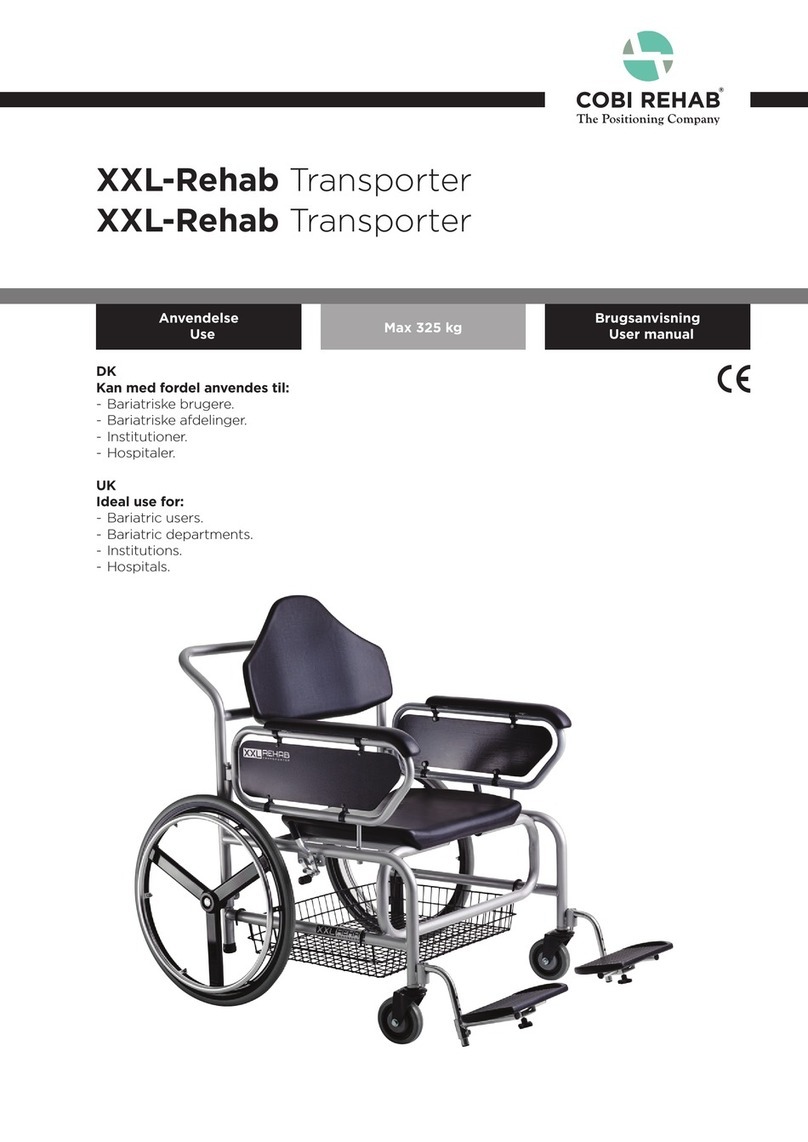
Cobi Rehab
Cobi Rehab XXL-Rehab Transporter user manual

Neatech
Neatech JOB User and maintenance manual
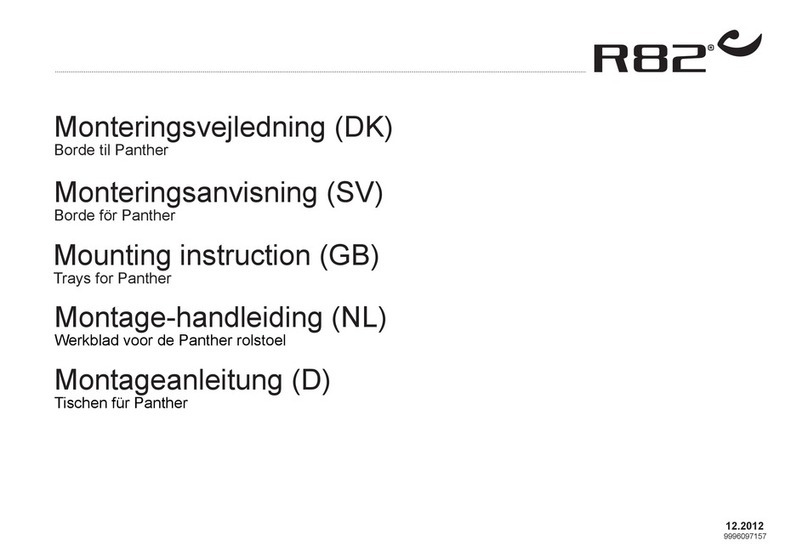
R82
R82 892 Series Mounting instruction
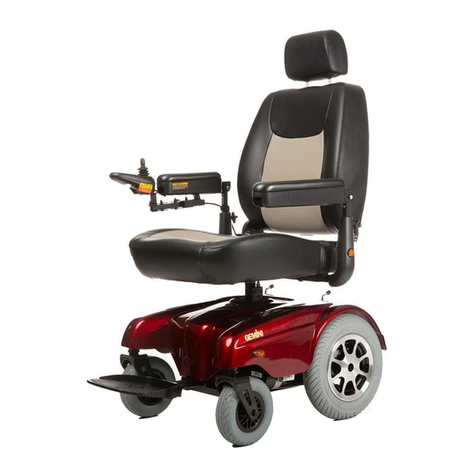
Merits
Merits P301 Series Service manual

